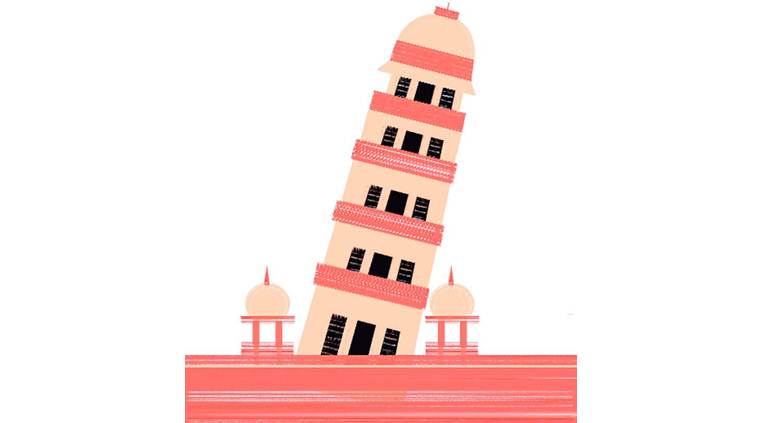- India
- International
SC has always upheld and strengthened secularism, but its Ayodhya ruling is problematic on that score
The Supreme Court decision leaves one with an impression that even if the majority community takes the law into its hands and destroys and damages a place of worship of any minority community, it can be rewarded, and the state can just wither away! This is the most unnerving
 The Supreme Court gave a further boost to secularism by its rulings in cases pertaining to the governance of the country. Illustration by C R Sasikumar
The Supreme Court gave a further boost to secularism by its rulings in cases pertaining to the governance of the country. Illustration by C R Sasikumar
India’s Supreme Court is acclaimed as the most powerful among its counterparts in the world. It has rewritten the Constitution of the country on several major issues. It has even become the third chamber of Parliament. Its verdict in the Ayodhya case must be evaluated in this light.
The founding fathers of the Constitution gave us an enlightened, forward-looking basic law, which is not just a legal document but is aimed at bringing about socio-economic transformation in the country. Secularism is an important precept underlying the framework of fundamental rights. But, as in several other areas, there is a considerable divergence between the precept and the reality. Significantly, the Constituent Assembly failed to agree on the definition of the word “secular”. It also could not agree on calling the Constitution secular. It was only during the Emergency in 1976 that the word secular was introduced in the preamble to the Constitution by the highly controversial 42nd amendment. Secularism acquired a new status when the Supreme Court declared it as a part of the basic structure of the Constitution. Whenever the concept of secularism is under threat, this injunction of the Court is invoked.
The Supreme Court gave a further boost to secularism by its rulings in cases pertaining to the governance of the country. Particular reference may be made to the decisions of the Court on Article 356 of the Constitution, which have totally stopped the widespread and continuous misuse of this article by successive central governments. After the demolition of the Babri Masjid, in the Bommai case (1993), mere apprehension that the BJP-ruled states in Himachal Pradesh, Madhya Pradesh and Rajasthan would not conduct themselves according to the dictates of secularism, was considered justification enough for their dismissal. The Court had gone to the extent of declaring that “in matters of state, religion has no place”. It said: “No political party can simultaneously be a religious party. Politics and religion cannot be mixed. Any state government which pursues unsecular policies or unsecular course of action acts contrary to the constitutional mandate and renders itself amenable to action under Article 356.”
Against this background of upholding and strengthening secularism, the Supreme Court’s Ayodhya verdict is disconcerting. A question needs to be asked, and answered, whether the decision will go to even sustain, leave aside strengthen, secularism in the country. This is particularly important in the context of the majoritarian ethos increasingly evident in the last few years.
The court has held that clandestinely keeping Ram Lalla idols in the Babri Mosque on December 22, 1949, was wrong. It has also held that the wanton destruction of the mosque on December 6, 1992, was unlawful. Both these actions showed flagrant disregard for secularism; in fact, it was a total negation of secularism. Is giving five acres of alternate land to Muslims for construction of a mosque, as the court has done, then the most appropriate or adequate compensation? What about the psychological hurt caused to the Muslims by the destruction of their place of worship? The Court should have at least asked the state and central government to rebuild the mosque. Narasimha Rao, who was prime minister when the mosque was demolished, had made such an announcement in Parliament. He later said that he stood by the statement and wanted it fulfilled. In recent years, several churches too have been damaged in communal violence. I have, therefore, been advocating that a law must be enacted to provide that when any place of worship is damaged or destroyed in communal violence, the government should take the responsibility of repairing, reconstructing and even rebuilding such places of worship. This will be one way of translating secularism into reality and creating a sense of confidence among the minorities.

Particularly disconcerting is the unanimity among the five judges in this decision of the apex court. Does it mean that the boundaries set by this judgment are the limits to secularism in India? The Supreme Court decision leaves one with an impression that even if the majority community takes the law into its hands and destroys and damages a place of worship of any minority community, it can be rewarded, and the state can just wither away! This is the most unnerving. The affected minority community becoming dejected and despondent in such circumstances can have dangerous portents for the future.
In any civilised country, protecting the interests of minorities must be accepted as the special responsibility of the majority community. Communal riots in Mumbai in December 1992-January 1993, following the demolition of the Babri Masjid, and the Gujarat riots in 2002 have shown this convincingly. The resultant sense of insecurity created among minorities goes to increase their ghettoisation and strengthens the forces of identity politics.
Under the distribution of powers between the states and the Centre, all these matters fall within the purview of the state governments. But, there must be a national policy to address these vital concerns, which would lay down legal and institutional framework for the purpose. Unfortunately, in the name of federalism and safeguarding the rights of state governments, it is becoming increasingly difficult to address these concerns. Even the constitutional forum of the inter-state council, comprising the prime minister, concerned central ministers and state chief ministers, has fallen into disuse.
In spite of infirmities, the judgment must be accepted by all parties to end this long-standing, explosive dispute. But, the implications of the judgment will be debated for years to come. For, what is at stake is the stability and integrity of the country and communal peace and harmony.
This article first appeared in the print edition on November 19, 2019 under the title ‘A disconcerting verdict’ The writer, a former Union home secretary, is the author of The Babri Masjid-Ram Mandir Dilemma: An Acid Test for India’s Constitution
EXPRESS OPINION
Apr 25: Latest News
- 01
- 02
- 03
- 04
- 05










































